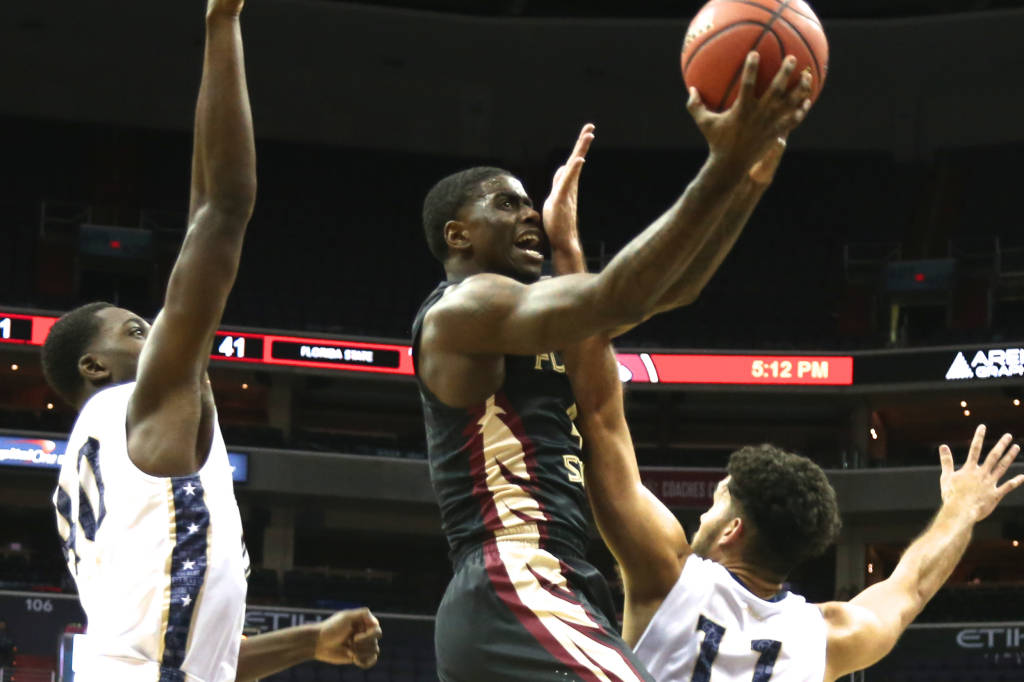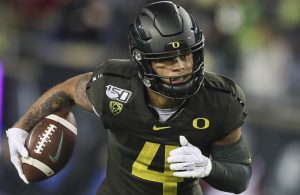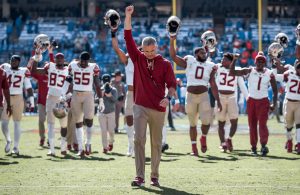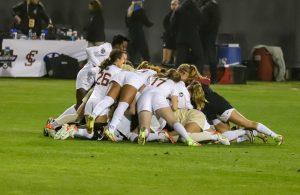- Sunday Seminole Summary: FSU Football Adds Pair of WR Transfers
- Sunday Seminole Summary: FSU Football Exits ESD With Top-15 Class
- Sunday Seminole Summary: FSU Soccer Tops BYU for Third National Championship
- Sunday Seminole Summary: FSU Soccer Advances to National Championship Match
- Seminole Sunday Summary: FSU Soccer Heads Back to College Cup
- Seminole Sunday Summary: FSU Soccer Reaches Sweet 16; Football Tops Boston College
- Seminole Sunday Summary: FSU Soccer Wins ACC, Advances to Second Round of NCAA Tournament; FSU Football Rallies Past Miami
- Seminole Sunday Summary: FSU Soccer Tops Wake on OT to Advance to ACC Final
- Seminole Sunday Summary: FSU Football Crushes UMass for Third Straight Win
- Seminole Sunday Summary: FSU Soccer Stays Perfect with Pair of Wins
FSU Hoops: Things to Know From the Non-Conference
- By Clint Eiland
- Updated: December 24, 2016
 wlpearce.com/FSU athletics
wlpearce.com/FSU athleticsWe get it. November was in the thick of college football season, and the Florida State football team was attempting to finish strong after a tumultuous beginning. Heck, the games against Syracuse and Boston College were probably more competitive than the basketball games against Charleston Southern and Winthrop. Add in the fact that FSU athletics has been football centric since the 1970s, and it’s not surprising that basketball quietly got off to one of the best starts in school history.
The Seminoles are up to No. 21 in the AP Poll, with an overall record of 12-1 before conference play begins after Christmas. In terms of advanced stats, Kenpom ratings put the Seminoles at 29th overall, 23rd in adjusted offensive efficiency, and 45th in adjusted defensive efficiency.
How did they get here? Don’t worry if you haven’t been following men’s basketball all that closely this season. The Daily Nole has you covered once again, with the biggest developments of the season described below. Follow our postgame coverage as well throughout the season to keep up with the latest analysis and quotes from head coach Leonard Hamilton and the players.
FSU Has Tons of Depth
This facet of the team is probably the most encouraging and the most notable of any on the list. 11 different players have performed in at least 10 games, and all 13 have averaged at least 10 minutes per appearance. Some of that is due to blowouts getting the backups minutes, but much of it really is Hamilton’s rotations. It helps newcomers like Braian Angola-Rodas and C.J. Walker get adjusted to the college game, and also helps veterans like Dwayne Bacon and Xavier Rathan-Mayes stay fresh. The Seminoles this year have rarely found themselves in a “rut” during games, largely because of their ability to maintain energy on the floor.
Jonathan Isaac is Living Up to His Billing
Coming into the season, Isaac was expected to immediately contribute as a scorer. He’s done that and more. Isaac averages the second most points per game with 12.9, but he also surprisingly averages a team best 7.0 rebounds per game. He’s clearly comfortable around the rim, and Hamilton has instilled a habit of crashing the boards after almost every shot. Add in his 11 blocks (third most) and 13 steals (tied for second most) and Isaac is developing into an all-around player. He’s not without his struggles. Sometimes he gets cold and stops shooting, and he struggles to defend faster guards/forwards, but he’s already impressed in areas not many expected him to.
Dwayne Bacon is Still the Best Player on the Team
Have no doubt though: Dwayne Bacon is still clearly the best player on the team. The stats themselves are kind to him, averaging 16.9 points per game and 4.1 rebounds on 47 percent shooting. But his impact on defense and his general leadership are hard to quantify, despite being fairly obvious. He’s improved as a defender on the wing, rarely letting players blow by him to the basket, and he remains stout inside.
What’s still incredible is his ability to completely take over a game. Look no further than the Florida contest this month; Bacon erupted in the second half with 16 points and gave the Seminoles a consistent scoring presence against a tough defense. This was in a game where FSU’s big men were inconsistent and Jonathan Isaac was having trouble adjusting to a rivalry atmosphere. Through it all, Bacon excelled with 24 points and helped lead his team to victory.
3-Point Shooting Has Markedly Improved
Having players that can stretch the floor is vital for any offensive system. For the past couple of seasons, the Seminoles did not have that. The 2014-15 team shot an atrocious 31 percent from beyond the arc, good for 298th in the nation. The Seminoles improved to 34 percent the next year (197th) and have finally managed to get it up to a decent 36 percent (115th). It’s still not overly impressive, but it does present a threat for opposing teams.
This improvement has come off the back of newcomers. Jonathan Isaac shoots almost 42 percent from 3-point range, but P.J. Savoy is quickly becoming the main deep shooter. Despite only appearing in six games so far, Savoy has made 49 percent of his 35 attempts, oddly enough putting him at third in points per game with 9.8. Another reason for the overall improvement has been Dwayne Bacon. Last season he only shot 28 percent from downtown, but he has greatly improved this year to nearly 36 percent, even though he’s taking more shots. While 3-point shooting might not be a “strength”, it is no longer the glaring weakness it once was.
Michael Ojo Is a Legitimate Post Presence
It turns out that Ojo’s injury last year did not set back his development much (if at all). He’s by no means dominant or tearing up the college basketball world. But he has begun to carve out a distinct role in FSU’s offense, and improved in enough areas that he is no longer a liability. He’s still being worked in gradually with a little over 13 minutes per game, but that seems to be best for him at this point. Ojo has learned how to use his size under the rim, allowing him to garner a team leading 27 offensive rebounds, which has contributed to his rise in points per game with 5.8. Defensively, he is still fairly one-dimensional, but his 16 total blocks so far are still a positive sign.
The most encouraging sign of development? His free throw shooting. Before this year, the highest he had shot in three seasons was 42.6 percent. He has hit an astonishing 73.7 percent this season. That’s not on limited opportunities either. Ojo has gone to the line for 38 shots, showing that he has become adept enough to draw fouls down low.
Defense Is Still a Work in Progress
No, the Seminoles’ defense is not bad. They actually rank 45th in adjusted defensive efficiency according to Kenpom rankings. That’s not the No. 1 it was in 2011-12, but it’s also not the 81st it was in 2015-16. Where the defense stands to improve the most is consistency. The Seminoles clearly have the athletic ability and willingness to become great. In certain games like against Florida and Minnesota, they have moments of top 10 defensive play. However, they also have extended defensive lapses that let teams hang around longer than they should. These latter moments caused them to blow an 18-point lead to Temple and allowed the rivalry contest against Florida to become a nail-biter. The ACC is too deep of a conference to have those types of lapses multiple times a game. If it can become consistent, the FSU defense might be the reason for even more victories.
It’s not hard to see where the improvement comes from. Ojo, Christ Koumadje, and Jarquez Smith have done well improving their defense in the post, while guards like Rathan-Mayes have become tenacious on the wing. Speaking of Rathan-Mayes…
XRM Seems to Have Figured Out His Role
Rathan-Mayes’ first two years in action were full of ups-and-downs. His freshman season witnessed plenty of losses, but also put the spotlight on him as a potential star. His sophomore season was riddled with inconsistent efforts and frustration within the locker room. This season? He’s in sync with his teammates and playing some of the best ball of his career. FSU finally has the right mix of players to shoulder the scoring load, allowing XRM to focus on becoming the fantastic defender that most knew he could. He’s probably the best wing defender on the team, and does a great job harassing point guards to prevent them from getting into a rhythm. But don’t think the other parts of his game have declined. He still averages 10 points per game and a team-high 4.7 assists.
Closing Out Games is Still An Issue
We previously went more in depth with this issue. Florida State, for whatever reason, has been noticeably bad at finishing games strong. How much of that is effort versus other teams getting hot is still a bit unclear. Against Florida at least, the Seminoles were defending decently, though KeVaughn Allen was on a tear and probably should’ve been denied the ball more. With games like Minnesota and Temple, it genuinely seemed like the Seminoles just entered cruise control in the final minutes of the game. Assembling big leads can allow teams to do that, but when the opponent begins to make it close time-after-time, it signals that half effort won’t be good enough to consistently win games. The Seminoles need to figure this out before ACC play starts on Wednesday.




You must be logged in to post a comment Login